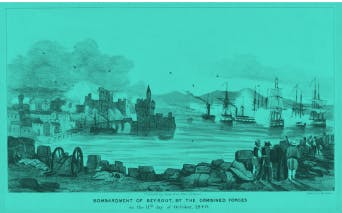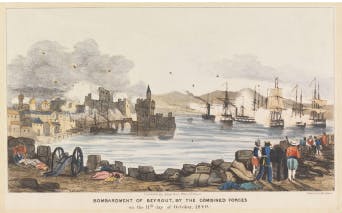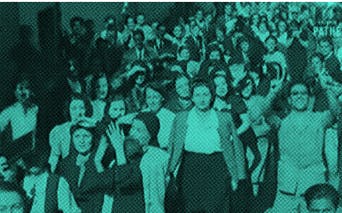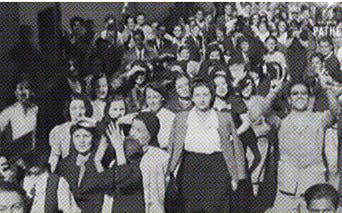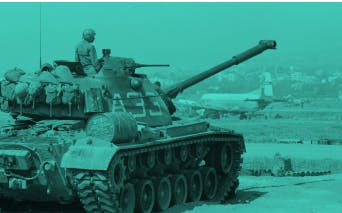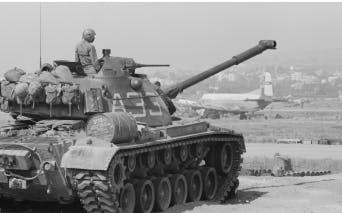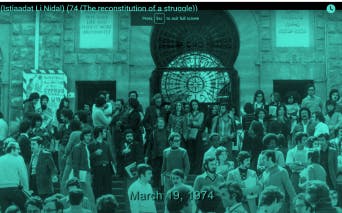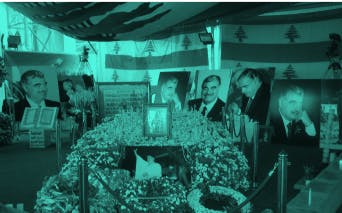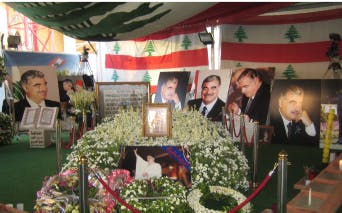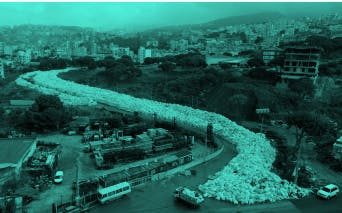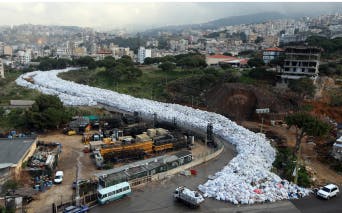AbiYaghi, Marie-Noëlle, and Léa Yammine. ‘The October 2019 Protests in Lebanon: Between Contention and Reproduction,’ Lebanon Support (2020).
Ammoun, Camille. Octobre Liban. Paris: Incultedermarge, (2020).
Armed Conflict Location & Event Data Project (ACLED), ‘Breaking the Barriers: One year of demonstrations in Lebanon.’ ACLED (2020).
Assi, Abbas. ‘Lebanon’s Protest Movement of 2015 and 2019: A Comparative Analysis.’ Freidrich Naumann Stiftung (2020).
Assi, Abbas. ‘Sectarianism and the Failure of Lebanon’s 2019 Uprising’. Middle East Insights, no. 251 (2020).
Baumann, Hannes. ‘Dumping Humpty-Dumpty: Blockages and Opportunities for Lebanon’s Economy after the October 2019 Protests’. South Atlantic Quarterly, 120 (2021), 456–63. https://doi.org/10.1215/00382876-8916204.
Daher, Joseph. ‘Hezbollah and the Lebanese Popular Movement,’ European Institute of the Mediterranean, February (2020).
Dahrouge, Elias, Jihad Nammour, and Ahmed Samy Lotf. ‘The 17 October 2019 Protests in Lebanon: Perceptions of Lebanese and Non-Lebanese Residents of Tripoli and Surroundings.’ Global Campus Human Rights Journal, 4 (2020), 488-516.
Dib, Kamal. ‘Predator Neoliberalism: Lebanon on the Brink of Disaster’. Contemporary Arab Affairs, 13 (2020), 3-22.
Fakhoury, Tamirace. ‘The Unmaking of Lebanon’s Sectarian Order? The October Uprising and its Drivers.’ Istituto Affari Internazionali, 66 (2019).
Fawaz, Mona, and Isabela Serhan. ‘Urban Revolutions: Lebanon’s October 2019 Uprising - Spotlight On Urban Revolts’. IJURR (2020). https://www.ijurr.org/spotlight-on/urban-revolts/urban-revolutions-lebanons-october-2019-uprising/.
Ghanem, Hiba. ‘Spatial Profanation of Lebanese Sectarianism: Al-Nūr Square and the 17 October 2019 Protests’. Journal for Cultural Research, 25 (2021), 160–74. https://doi.org/10.1080/14797585.2021.1899891.
Ipek, Yasemin, ‘Activists-in-becoming: Lebanon’s October 17 Revolution and Its Afterlives,’ Member Voices, Fieldsights (2020), https://culanth.org/fieldsights/activists-in-becoming-lebanons-october-17-revolution-and-its-afterlives
Karam, Jeffrey G., and Rima Majed. The Lebanon Uprising of 2019: Voices from the Revolution. London: Bloomsbury Publishing, (2022).
Khater, Lea Bou. ‘Lebanon’s October 2019 Revolution: Inquiry into Recomposing Labor’s Power’. South Atlantic Quarterly, 120 (2021), 464–72. https://doi.org/10.1215/00382876-8916218.
Khatib, Dania Koleilat. ‘17 October (2019) Revolution in Lebanon: A Preliminary Analysis’. In New Wave of Revolutions in the MENA Region: A Comparative Perspective, edited by Leonid Issaev and Andrey Korotayev, 75–93. Cham: Springer International Publishing, 2022. https://doi.org/10.1007/978-3-031-15135-4_4.
Khattab, Lara W. ‘The Genealogy of Social and Political Mobilization in Lebanon under a Neoliberal Sectarian Regime (2009–2019)’. Globalizations (2022): 1–18. https://doi.org/10.1080/14747731.2021.2025296.
Khawam, Grace. ‘“What About Us?”: The Unheard Voices of the Lebanese Revolution’. Kohl: A Journal for Body and Gender Research, 6 (2020), 221–29. https://doi.org/10.36583/2020060209.
Kosmatopoulos, Nikolas. ‘Unhatching the Egg in Lebanon’s 2019 Protests’. South Atlantic Quarterly, 120 (2021), 446–55. https://doi.org/10.1215/00382876-8916190.
Louis, Dima, and Michelle Mielly. ‘People on the Tweets: Online Collective Identity Narratives and Temporality in the #LebaneseRevolution’. Organization, 30 (2023), 89–115. https://doi.org/10.1177/13505084221137990.
Majed, Rima, and Lana Salman. ‘Lebanon’s Thawra’. Middle East Report (MERIP), 292 (2019).
Makdisi, Karim. ‘Lebanon’s October 2019 Uprising: From Solidarity to Division and Descent into the Known Unknown’. South Atlantic Quarterly, 120 (2021): 436–45. https://doi.org/10.1215/00382876-8916176.
Melki, Jad, and Claudia Kozman. 2021. ‘Selective Exposure During Uprisings: Examining the Public’s News Consumption and Sharing Tendencies During the 2019 Lebanon Protests’. The International Journal of Press/Politics, 26 (2021), 907–28. https://doi.org/10.1177/1940161220972892.
Mouawad, Jamil. ‘Teaching Lebanon’s Politics in Times of the Uprising’. South Atlantic Quarterly, 120 (2021), 473–80. https://doi.org/10.1215/00382876-8916232.
Musallam, Fuad, ‘Feeling political times: Notes from downtown Beirut during the uprising,’ Contemporary Theatre Review (2020), 294.
Osman, Khalil Fadl. ‘Revolution and Counter-Revolution in the Tripoli Protests in Lebanon’. Protest, 2 (2022), 29–54. https://doi.org/10.1163/2667372X-bja10022.
Porta, Donatella della, and Rossana Tufaro. ‘Mobilizing the Past in Revolutionary Times: Memory, Counter-Memory, and Nostalgia During the Lebanese Uprising’. Sociological Forum, 37 (2022), 1387–1413. https://doi.org/10.1111/socf.12843.
Rønn, Anne Kirstine. ‘The Struggle of Unifying a People in Fragments’. PhD Thesis, Denmark: Aarhus University, 2022.
Sarej, Nader. Outcry: A Rhetorical Discourse Analysis of the Lebanese Uprising [Sarakha al-ghdab: Dirasa bilaghya fi khitabat al-intifadah lubnaniya], Doha: The Arab Centre for Research and Political Studies, (2021).
Sinno, Wael. ‘How People Reclaimed Public Spaces in Beirut during the 2019 Lebanese Uprising’. The Journal of Public Space, 5 (2020): 193–218. https://doi.org/10.32891/jps.v5i1.1258.
Vértes, Sára, Chris van der Borgh, and Antoine Buyse. 2021. ‘Negotiating Civic Space in Lebanon: The Potential of Non-Sectarian Movements’. Journal of Civil Society, 17 (3–4): 256–76. https://doi.org/10.1080/17448689.2021.1994202.
Ziadeh, Khaled and Mohammed Abi Samra. Lebanon’s October Uprising: Squares and Testimonies [Intifadah 18 tishreen fi lubnan], Doha: The Arab Centre for Research and Political Studies, (2022).






















